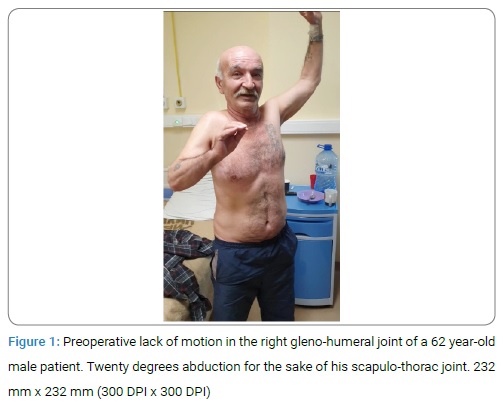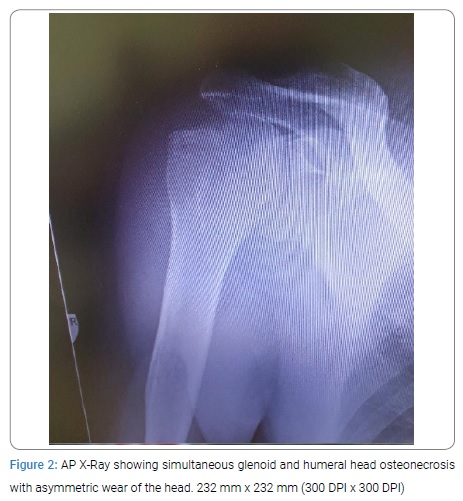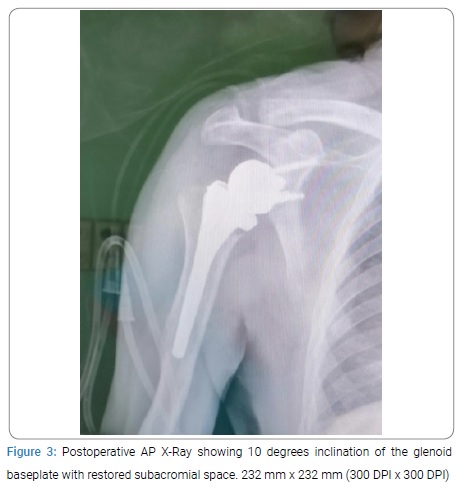Abstract
A 62-year-old male patient presented with pain accompanied by lack of motion in his right shoulder joint. The MRI finding was humeral head and glenoid osteonecrosis of the right shoulder. Although rare, osteonecrosis of the humeral head is sometimes accompanied by simultaneous osteonecrosis of the glenoid cavity thus blocking the motion in the shoulder. Reversed shoulder arthroplasty is the best option for restoration of the pain free mobility of the joint.
Key Clinical Message
A 62-year-old male patient presented with pain accompanied by lack of motion in his right shoulder joint. The MRI finding was humeral head and glenoid osteonecrosis of the right shoulder. Although rare, osteonecrosis of the humeral head is sometimes accompanied by simultaneous osteonecrosis of the glenoid cavity thus blocking the motion in the shoulder. Reverse shoulder arthroplasty is the best option for restoration of the pain free mobility of the joint.
Case Description
A 62-year-old male patient, presented with increasing pain and lack of motion in his right shoulder over the last six months. From his medical history there was nothing noteworthy. Physical examination did not reveal any neurologic deficit or any other finding. Static X-rays revealed the presence of omarthrosis, with simultaneous glenoid and humeral head osteonecrosis. The range of motion in his right shoulder was limited to 20 degrees for the sake of his scapulo-thoracic joint. The clinical tests revealed no motion in his gleno-humeral joint (Figure 1).

AP X-ray showed proximal migration of the humeral head with impingement in the acromion and simultaneous glenoid and humeral head osteonecrosis with asymmetric wear of the head (Figure 2).

Operative treatment with reverse shoulder arthroplasy was the chosen therapeutic strategy (Figure 3).

After 6 months, his clinical condition had been significantly improved and the range of motion in the affected shoulder was almost normal.
The simultaneous humeral head and glenoid osteonecrosis is rarely observed. In most cases omarthrosis is caused by asymmetric wear and proximal migration of the humeral head with rotator cuff tears. In the remaining cases it is secondary to neglected or poorly treated proximal humerus fractures. The incidence of simultaneous glenoid and humeral head impairment is estimated at ~0.9 per 1000 shoulder arthritis patients [1]. Reversed shoulder arthroplasy is the most biomechanically appropriate surgical technique for this rare degenerative disease of the upper extremity [2].
Competing Interests
The authors have nothing to declare.
Author Contributions
Vladimir Stavrev: Designed, drafted and wrote the manuscript.
Petko Ganev: Acquired all examination images and other pertinent patient data.
Jannis Papathanasiou: Contributed to critical analysis of the submitted material.
Keywords
Shoulder pain; Humeral head; Glenoid osteonecrosis; Reverse shoulder arthroplasy
Cite this article
Stavrev V, Ganev P, Papathanasiou J. Reverse shoulder arthroplasty for humeral head and glenoid osteonecrosis. Clin Case Rep J. 2020;1(1):1–2.
Copyright
© 2020 Vladimir Stavrev. This is an open access article distributed under the terms of the Creative Commons Attribution 4.0 International License (CC BY-4.0).



